As the Associated Press reported:
With the return of a long-sought masterpiece of antiquity, Italy on Friday trumpeted one of the successes of its campaign to recover what it says are looted treasures from museums and collectors around the world.
The 2,500-year-old vase by Greek artist Euphronius, which Italy regained after signing a deal with the Metropolitan Museum in New York, was feted in Rome at an official presentation.
The Euphronius Krater – a large vase painted with scenes related to Homer’s epic poems “The Iliad” and “The Odyssey” – is regarded as one of the finest examples of its kind. The vase was used as a bowl for mixing wine and water.
“It is universally considered the best work by the artist,” Culture Minister Francesco Rutelli said at the ceremony. Also attending was his predecessor, Rocco Buttiglione, who started the country’s high-profile campaign to recover art.

The Sixth Century BCE was a golden age of Greek vase painting, with innovations and individual styles proliferating at an unprecedented pace. Perhaps not coincidentally, the first signed vases had appeared only at the beginning of that century. Soon after came revolutions in figure painting technique and the first explicit attempts to realistically depict the physical world.
Euphronius was one of a group of vase painters whose work was as revolutionary as would be that of Cavallini, Cimabue, Duccio, and Giotto, some 1800 years later. To understand the depths of this revolution, all one need do is think of their predecessors, from highly stylized Egyptian and Near Eastern art to even the stunningly vivid and vivacious art of the Minoans. In the former two realism wasn’t even considered; in the latter, it was only, albeit marvelously, attempted.
By the latter half of the century, Greek vase painting was already highly sophisticated, although the prevalent engraved black-figure technique limited the amount of possible detail rendering. Even so, working with it, Exekias took what is considered to have been the first bold step in Western Art towards realistically rendering the physical world.
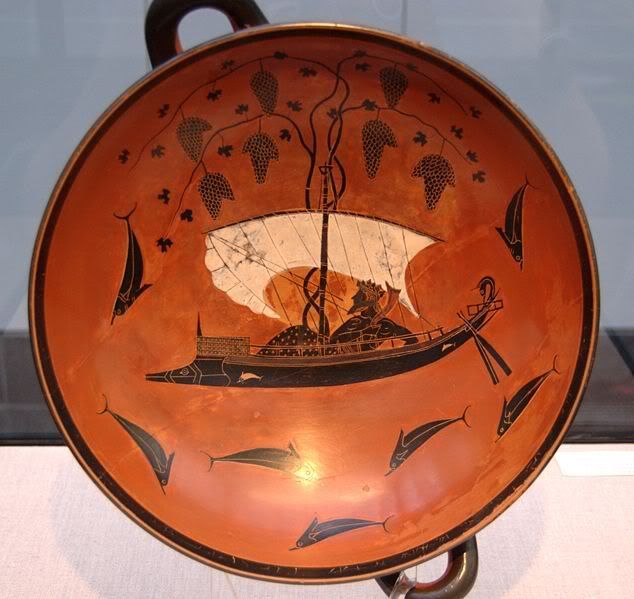
Notice the sail, billowed by the wind. As far as is known, this was the first such attempt to represent an actual physical force in action. As Helen Gardner put it:
From Exekias’ sail on, Greek art manifests an increasing comprehension of physical nature as it is apprehended by vision.
(Full size image here)
Soon thereafter, the Andokides Painter, who may have studied under Exekias, invented red-figure painting, transforming the history of art. This new technique reversed the color scheme, with backgrounds now black and figures red, but more important was that its easier flowing and more consistent drawing point allowed the depiction of much finer details. Such capability inspired a wealth of innovation, and that brings us to Euphronius.
First, look at this Equestrian Lesson, by Euphronius’s teacher, Oltos:
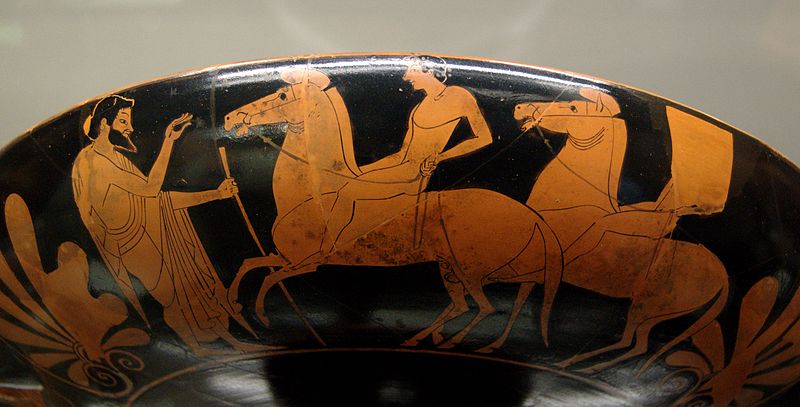
Note the simplicity of line, and the lack of anatomical detail. The figures are mere outlines.
(Full image here)
Now, check out the Music Lesson, by Euphronius’s contemporary, Phintias:
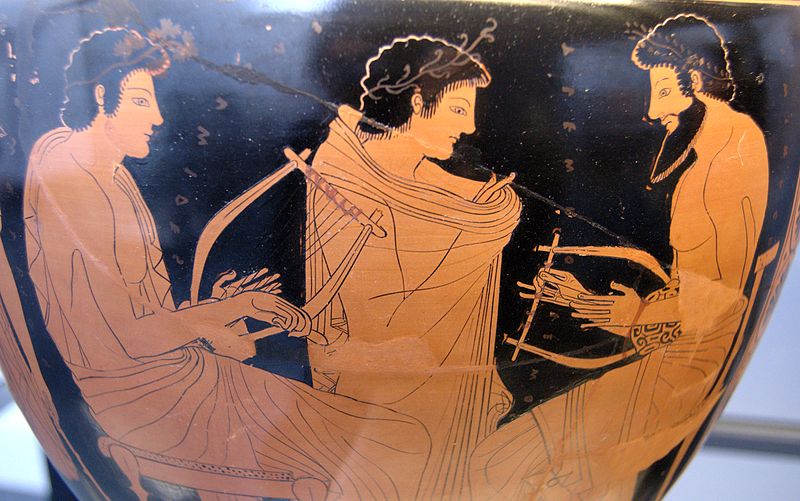
Again, the anatomy is mere outline, and the abstractly stylized draperies fall unrealistically.
(Full image here)
So, here’s a close-up of the Euphronius Krater. The painting represents Hermes, Thanatos, and Hypnos carrying the dead Sarpedon to Hades:
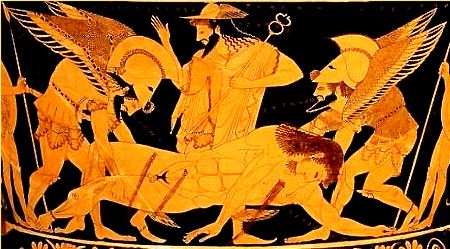
Note the rendering of the abdomenal and arm muscles, on the dead Sarpedon. Nothing like that had been previously attempted.
Gardner, again:
Euphronius was among the first to devote himself seriously to the study of anatomy, and he was famous for this even in his own time.
And here’s the reverse side painting:
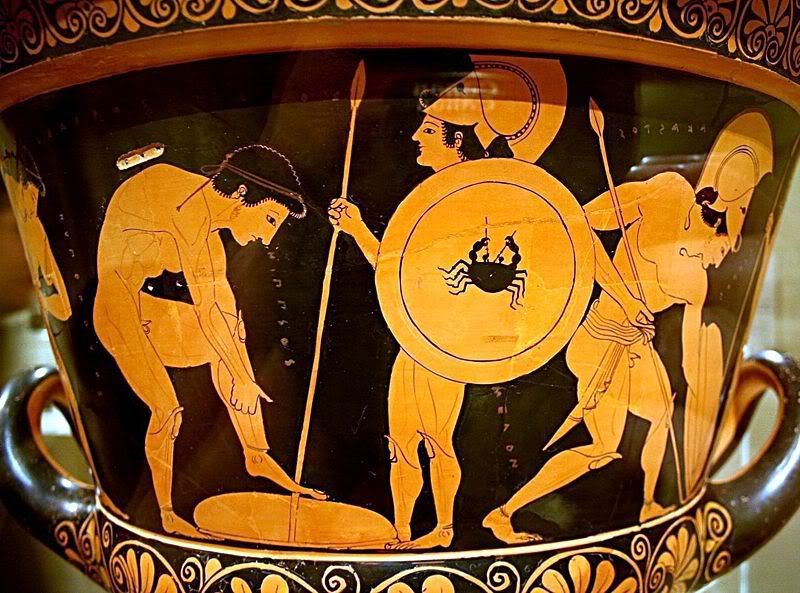
Again, note the delineated musculature, on the arms, legs, and abdomen.
(Full image here)
Until Euphronius, even the idea of applying anatomical studies to art was unheard of. The realization that it was possible to accurately depict what is seen in the world, and then to systematically attempt to learn about the physical world in order to facilitate creating such depictions, was unprecedented. It wasn’t only about art, it was a fundamental shift in consciousness, and it it was part of the developing Greek sensibility that would lead to the birth of abstract philosophies and sciences, and thematic theater, a century or so later.
Here’s another example, from Euphronius. It’s a painting of Herakles wrestling Antaios, on another krater. Again focus on the incised musculature, and understand that nothing like that had ever before been attempted in the known history of art.:
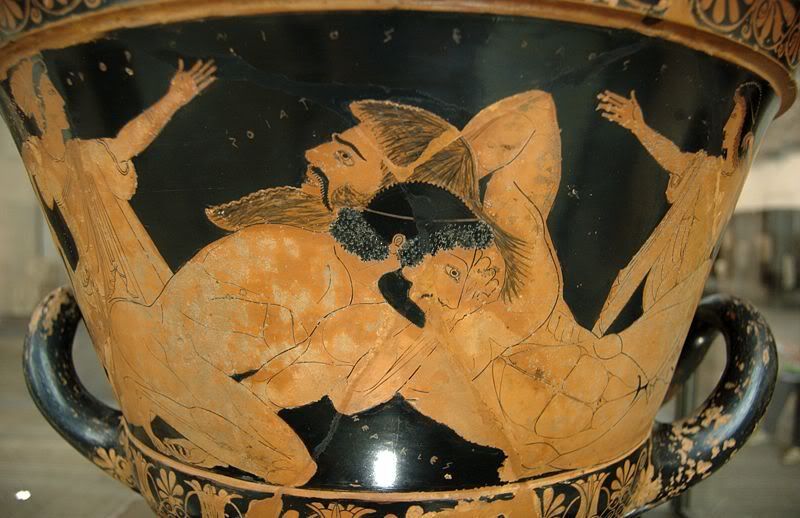
You can see the full krater here, and a close-up of the Herakles scene here.
Before closing, let’s also look at Euphronius’s great contemporary and competitor, Euthymides. This amphora has what is regarded as his greatest painting:

First notice the lack of anatomical detail. Euthymides had a different focus than did Euphronius. He was concerned with developing foreshortening, and showing figures from different viewpoints. He almost pulls off a figure who is twisting, showing both side and back views. He also shows figures moving, and the central figure, with his forward leg striding ahead, broke an artistic tradition, going back to the 31st Century BCE Egyptian Palette of Narmer, of advancing the far leg to show such motion. Most important, though, is the very conception of movement.
This painting, with the central figure turning, and the two flanking figures dancing, their legs raised and arms held out for balance, is an example of Euthymides’s revolutionary artistic attempts to depict realistic beings, freely mobile in a living space. These are no longer flat two-dimensional surface drawings, but fully functioning three-dimensional volumes. Euthymides, too, was not only reinventing art; his attempts to observe and replicate physical reality were part of a movement that radically reconceptualized the world.
(Full image here)
This particular amphora also provides evidence of the earliest known artistic rivalry, for on it Euthymides inscribed:
As never Euphronius
Which has been interpreted to mean, essentially: Euphronius never did anything like it!

19 comments
Skip to comment form
to be living in a Dark Age, when art such as this isn’t created.
A Dark Age presided over by a moron who couldn’t care less.
Author
this looked great in preview. the preview must be waaaaaaay off.
belong in Greece?
…I thought Judge Crater had been found.